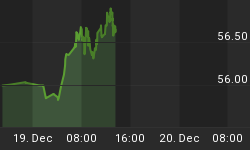Since the beginning of COT (March 1995), the commercials have only held a net short position as a percentage of open interest of more than 44% three times. In two of these instances - April 6 and April 12, 2004 - the extremely large commercial short position presaged a massive decline in the price of gold. As for the only other time that the net commercial short position as percentage of open interest has been above 44%, it was last week...

Since 2003 changes in the NCSPOI have coincided with the expected change in the price of gold 68.91% of the time. In other words, when the commercials are adding to their shorts the price of gold is usually rising, and when the commercials are reducing their short position (or profiting) the price of gold is usually declining. That the NCSPOI has nowhere to go but down strongly suggests that the price of gold is about to correct. That is, of course, unless the motherload gold rally is near, in which case the commercials will default as they chase the price of gold north of $1650 (Sinclair's target).
As if continually trying to cheat death, many gold gurus argue that things will be different this time. For example, Ted Butler - who has vast experience analyzing the silver/gold markets - suggested in his latest commentary that 'there has been a profound change in the gold COTs'. After providing no proof of this conclusion, Butler goes on to suggest - for some unknown/unexplained reason - that since a new noncommercial entity is in the market this 'could be profoundly bullish'.
I think there has been a profound change in the gold COTs. While the non-commercial large trader long category is at a level suggesting the tech funds are on the long side of gold in a big way, I don't think it is the tech funds that are long gold. Yet. I think some other, very large, non-tech fund buyers entered the market and bought what the tech funds were selling on the break from previous highs above $445 in March. Just like what occurred in silver a few months ago. You must remember that while changes in the non-commercial category are almost always the result of tech fund activity, the tech funds are not the only traders in that category. So while most think the tech funds are already on the long side in gold (and silver), I don't see it that way.
I don't want to dwell too deeply (for personal reasons) on why I say it's not the tech funds that are heavily long, other than to say they never got buy signals (until today) and the concentration ratios in the COT for the long side say it isn't them. The good news, of course, is that until the tech funds do accumulate a large long position, the chance of a major sell-off is slim.
Two important, related questions Butler neglects to ask are:
1) Is this new noncommercial gold bull as well funded as the commercials?
2) Will this new noncommercial gold bull be able to handle the pressure if the commercials throw sell orders for 60,000+ contracts at the gold market tomorrow?
Regardless of how you care to answer these questions, Butler is correct in that when the tech funds accumulate a large long position gold usually corrects. However, whether today's tech fund long position is 'large' or not is open for debate. If you disregard speculation of a new mysterious noncommercial force, the position looks pretty large to me.

"At face value, the dealers' and tech fund positions are reflective of a top and not a bottom." - Butler
A Manipulated Market is a Dangerous Market
The COT dynamics that have been controlling price swings in gold since 2002 may change in the future; the commercials may be forced to cover and the tech funds may end up laughing all the way to the bank. However, the important point to remember is that the commercials are, quite literally, the bank.
"The bottom line is that the COTs in silver and gold must be read with a filter that incorporates a new entry of a speculative trader on the long side." - Butler
Contrary to Butler's opinion, the bottom line - much like the ling being touted in this space right before last years gold/silver price collapse - is that the COT suggests that price of gold and silver are headed for a correction unless some major market moving event transpires (ie. the US dollar crashes). To be sure, that the POG is [probably] being manipulated by the evil commercials isn't a reason to go long in the near term, it is reason to be very afraid.
"My main purpose has been to end the silver manipulation and encourage all to investigate and then buy real silver." - Butler















